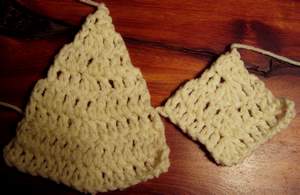|
Crochet Decrease
|
A crochet decrease can be a daunting task at first. You see this jumble of letters and think..."What on earth is that supposed to mean?" Well, it's just another abbreviation to learn. Let's get on with telling you how each one works.
Basically, decreasing is all about reducing the number of stitches you are working with. This can be to form a pattern or to make shapings in a garment. If you make a hat from the bottom up, you decrease to shape the crown.
Usually decreasings are worked several times in a row and often they are placed at regular intervals along a row. This is true with ripple patterns - they are worked with alternating increases and decreases forming the ripple effect.
The more stitches you decrease all together (ie. dc5tog), the narrower or tighter the 'V' will be. The less stitches decreased together (ie. sc2tog), the wider or looser the 'V'. You can see this on the picture at the top of this page. The decreasing on the left is 'dc2tog' and on the right it's 'dc4tog'. See the difference? The point of the one on the right is more pronounced.
Now, the most common ways for crochet decreases to be written are...
- sc dec - single crochet decrease
- sc2tog - single crochet 2 together
The instructions above both mean exactly the same thing and are worked in exactly the same way - only the words are different.
What you would do to crochet decrease as per the instructions above, is...
- push your hook through the next stitch space, yarn over, bring the yarn through to the front, then STOP. Do not do the final step of that stitch.
- Then, go to make another stitch in the next space indicated. Complete that stitch up to the same stage (3 loops on hook).
- Then, finish both stitches off together by pulling the last yarn over through all loops on hook. This forms a one stitch crochet decrease by reducing two stitches into one.
The same goes for any other stitches. What do I mean? Well - if you're working in double crochet then you might see...dc dec or dc2tog. Or - you may see...hdc dec or hdc2tog when you're working a pattern in half double crochet. Again, they all mean the very same thing - reduce the next two stitches down to one.
Now, the fun comes when you need to crochet decrease more than one stitch at a time. How do you do that? Easy!
You may see the likes of...dc3tog...what does this mean? You need to do the same as I explained above but with double crochets. That means you'd need to complete each stitch right up to just before the very last step then STOP. Leave that extra loop on the hook each time while you prepare the next stitches too.
Here's a tip - (this doesn't work with half double crochet) - you should always end up with one more loop on your hook than the decrease mentions (ie. dc3tog - you'd have 4 loops on your hook before you make the last move), then your last move is...yarn over and pull that through all the stitches on your hook.
So - that means with dc3tog you'd be decreasing 2 stitches in total - reducing three down to only one.
With Half Double Crochet you'll have twice as many loops on your hook as the number mentioned in the decrease, plus one that's already there. So - for a hdc3tog you'd have 7 loops on your hook before the last step of drawing your yarn through all loops.
Hope this makes sense to you. Try it - it'll all become clear.





